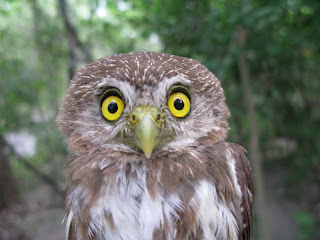Last week, I wrote about how people are more oriented towards looking, thinking of, and caring for animals from a utilitarian and charismatic point of view. Today I will try to intertwine my past opinion with another link: the unnoticeable minute species. In the literature, we can find several articles on conservation focused on big mammals and birds particularly addressing on site conservation issues. Using big charismatic vertebrate species as a flagship (i.e., a selected species used as a conservation cause or to represent an environmental cause to increase awareness and favorable efforts) for conservation has been proved to have some utility since the 80’s. Research has shown that by having only “cute” endangered mammals (sometimes called megafauna in risk of extinction), we could be missing entire islands where these species are absent or gone already.
Taken from http://www.hickerphoto.com/arctic-wildlife-hudson-bay-polar-bear-canada-29110-pictures.htm
As everything in life, this approach has its own shortcomings and drawbacks waiting for researchers to address and improve them. Birds, amphibians, and plants under different status of conservation concern and/or charismatic to people are also considered as flagships either for educating or informing our society of specific aspects of them and their environments.
In general species such as some small noncolorful birds, amphibians, insects, and, very especially, the “microbes” are frequently overlooked from conservation workshops, outreach activities, and education activities when addressing the open society. Microbes and invertebrates alone conform about 95% of all living species on Earth! so, are oriented to care for what is numerously dominant or by the size of what we see?.
Bacteria Nitrobacter. Taken fromhttp://ozsoapbox.com/goldfish/why-do-i-need-to-cycle-my-goldfish-tank/
Informing people about the past and current status, ecological values, basic natural history and relationships of these small creatures (e.g., invertebrates) with the “megafauna” and vital ecosystem services can improve the understanding of how several biological entities (inconspicuous or noncharismatic species) and environmental processes (e.g., nutrient cycling or regulation of population size) are interrelated and depend on each other at least in certain period of their life. For instance the flow of nutrients coming from the permanent change or shed of feathers, hairs, skin cells, leaves, branches, carcasses, and all organic material in decomposition are dependent on the activity first of small sensitive leaf litter creatures (insects, worms) and secondly of microbes (e.g., fungi and bacteria) to break them down into smaller particles (e.g., nutrients such as different presentations of nitrogen that is a structural element of protein for all living organisms) make them available over time to plants.
Plants use them for their own good (i.e., absorbing and transforming them into their bodies to create more live tissue or biomass) and then make them available (e.g., flowers, fruits, leaves, bark, wood) again to countless species of small and large terrestrial and aquatic organisms. All unnoticeable tiny species (i.e., fungi and bacteria) are very likely to gain appreciation of people as mammals, birds, amphibians and plants do. To put a cherry on this cake, let’s say that microbes in collaboration with plants are responsible agents driving agriculture, forestry, and fisheries. These activities mean food, work, money, health and several other prime services to us.
Thus, by informing people of the importance of appealing “megafauna” (e.g., polar bears, monkeys and jaguars), other charismatic species (e.g., colorful birds, frogs and plants) and their basic relationships with other non-attractive species of invertebrates (e.g., earthworms and beetles) and the imperceptible microbes (e.g., fungi and bacteria) we can provide a more complete image of how relationships and interdependencies play a key role in our ecosystems. Further, if we link these interrelationships among species to environmental factors and the ecosystem services resulting from them, there will be a better way to see and understand ecology in our society and to enhance the societal valuation of wild species and ecosystems. We can develop our major scientific topic during our conservation activities and, when possible, make a link to the other "imperceptible and little treasured" living species to provide a more complete ecological idea of our topic. Outreach and environmental education (in any format!) are two “open doors” to everyone who understand, cares, and wants to cooperate in giving a more complete picture of ecology to our society in favor of ecosystem conservation. Are we in? As for me concerns, I am in!












